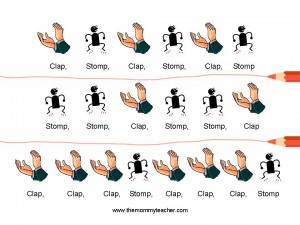Don’t write me off too soon! I have talked to a lot of moms of my kindergarten students who practically want to punch me in the face if I spend too long on this subject of patterns. They say “My child worked on patterns in Pre-K, and he (or she) picked up on it very quickly.”
Trust me, I understand, I teach the subject over and over again so I can also get a little burnt out on patterns myself, but as a teacher let me talk to you for a moment about patterns so you hopefully won’t roll your eyes with each pattern post.
When your little one learns about patterns he/she gets so excited and thrilled to practice this skill because it gives order and predictability to activities, and how things in life work together in general. After the concept of pattern is developed, children can predict that Tuesday comes after Monday, lunch comes after breakfast, and eventually they will learn that the number system is based on a pattern understanding that 12 comes after 11 because the tens place stays the same and the ones place follows a pattern of 1, 2, 3, etc.
So, the whole AB, AABB, ABC pattern lesson is a means to understanding the bigger picture of observing patterns in everyday life.
If your child understands certain aspects of patterns….GREAT….build on that. There is usually an aspect of patterns that can be taught to add to one learned.
First, patterns can be taught in rhythmic motion such as listening to a beat and predicting what might come next. Then, patterns are taught using color, shape, and arrangement. Then, patterns can incorporate a letter symbol. Then, patterns can be taught by extending all those skills with a higher level of difficulty. Then, patterns can be taught using numbers. Additionally, with these understandings, patterns can be observed naturally through everyday occurrences such as waking and sleeping, days of the week, seasons of the year, etc..
The main lesson in teaching patterns is that something repeats itself. So remember the “I do, We do, You do” teaching skill from the post “Math on my Fingers” today you are going to:
1) Start a pattern to a beat such as “Clap, pat (your legs), clap, pat, clap, pat……
2) Ask your child to join in; continue on for a minute or so. Then you are going to add the words saying “Clap, Pat, Clap, pat….”
3) “Let’s do another pattern using our bodies” Ideas: stomp, tap your head, snap, nod, tap your shoulders, flap your arms, etc.
4) Ask your child if they would like to come up with one for you or a family member to do. If your child does not follow a pattern, remind them that you want to pick one of two things that repeat themselves over and over again like the one you chose.
5) Practice variations of this over the next few days in my next math post I am going to add an extension activity for this same rhythmic pattern activity.
Consider purchase the following cubes, book (or a similar book) for the next few pattern lessons:

